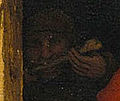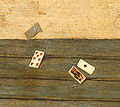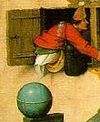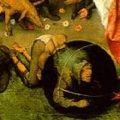| Proverb/idiom | Meaning | Area | Image |
|---|
| 001 | To be able to tie even the devil to a pillow (fr)(nl) | Obstinacy overcomes everything | Lower left |  |
| 002 | To be a pillar-biter (fr)(nl)(it)(lmo) | To be a religious hypocrite | Lower left |  |
| 003 | Never believe someone who carries fire in one hand and water in the other (fr)(nl) | To be two-faced and to stir up trouble | Lower left |  |
| 004 | To bang one's head against a brick wall (fr)(nl) | To waste one's time on an impossible task | Lower left |  |
| 005 | One foot shod, the other bare(fr)(nl) | Balance is paramount | Lower left |  |
| 006 | The sow pulls the bung (fr)(nl) | Negligence will be rewarded with disaster | Lower left |  |
| 007 | To bell the cat (fr)(nl) | To carry out a dangerous or impractical plan | Lower left |  |
| 008 | To be armed to the teeth (fr)(nl)(de) | To be heavily armed | Lower left |  |
| 009 | To put your armor on (fr)(nl) | To be angry | Lower left |  |
| 010 | One shears sheep, the other shears pigs (fr)(nl) | One has all the advantages, the other none | Lower left |  |
| 011 | Shear them but do not skin them (fr)(nl) | Do not press your advantage too far | Lower left |  |
| 012 | The herring does not fry here (nl) | It's not going according to plan | Lower left |  |
| 013 | To fry the whole herring for the sake of the roe (fr)(nl) | To do too much to achieve a little | Lower left |  |
| 014 | To get the lid on the head (nl) | To end up taking responsibility | Lower left |  |
| 015 | The herring hangs by its own gills (fr)(nl) | You must accept responsibility for your own actions | Lower left |  |
| 016 | There is more to it than (just) a single herring (nl) | There is more to it than meets the eye | Lower left |  |
| 017 | What can smoke do to iron? (fr)(nl) | There is no point in trying to change the unchangeable | Lower left |  |
| 018 | To find the dog in the pot (fr)(nl) | To arrive too late for dinner and find all the food has been eaten | Lower left [note 1] |  |
| 019 | To sit between two stools in the ashes (fr)(nl)(de) | To be indecisive | Lower left |  |
| 020 | To be a hen feeler (fr)(nl) | To be very miserly (feeling whether the hen is about to lay an egg before slaughtering it) | Middle left |  |
| 021 | The scissors hang out there (fr)(nl) | They are liable to cheat you there | Upper left |  |
| 022 | To always gnaw on a single bone (fr)(nl) | To continually talk about the same subject | Upper left |  |
| 023 | It depends on the fall of the cards (fr)(nl) | It is up to chance | Upper left |  |
| 024 | The world is turned upside down (fr)(nl)(de) | Everything is the opposite of what it should be | Upper left |  |
| 025 | Leave at least one egg in the nest (fr)(nl) | Always have something in reserve | Upper left |  |
| 026 | To crap on the world (fr)(nl)(de) | To despise everything | Upper left |  |
| 027 | To lead each other by the nose (fr)(nl)(de) | To fool each other | Upper left |  |
| 028 | The die is cast (fr)(nl)(de) | The decision is made | Upper left |  |
| 029 | Fools get the best cards (fr)(nl) | Luck can overcome intelligence | Upper left |  |
| 030 | To look through one's fingers (fr)(nl) | To turn a blind eye | Upper left |  |
| 031 | There hangs the knife (fr)(nl) | To issue a challenge | Upper left |  |
| 032 | There stand the wooden shoes (fr)(nl) | To wait in vain | Upper left |  |
| 033 | To stick out the broom (fr)(nl) | To have fun while the master is away | Upper left |  |
| 034 | To marry under the broomstick (fr)(nl) | To live together without marrying | Upper left |  |
| 035 | To have the roof tiled with tarts (fr)(nl) | To be very wealthy | Upper left |  |
| 036 | To have a hole in one's roof (fr)(nl)(de) | To be unintelligent | Upper left |  |
| 037 | An old roof needs a lot of patching up (fr)(nl) | Old things need more maintenance | Upper left |  |
| 038 | The roof has laths(fr)(nl) | There could be eavesdroppers (The walls have ears) | Middle left |  |
| 039 | To have toothache behind the ears(fr)(nl) | To be a malingerer | Middle left |  |
| 040 | To be pissing against the moon(fr)(nl) | To waste one's time on a futile endeavour | Middle left |  |
| 041 | Here hangs the pot(fr)(nl) | It is the opposite of what it should be | Middle left |  |
| 042 | To shoot a second bolt to find the first(fr)(nl) | To repeat a foolish action | Upper left |  |
| 043 | To shave the fool without lather(fr)(nl) | To trick somebody | Middle |  |
| 044 | Two fools under one hood(fr)(nl) | Stupidity loves company | Middle |  |
| 045 | It grows out of the window(fr)(nl) | It cannot be concealed | Middle |  |
| 046 | To play on the pillory(fr)(nl) | To attract attention to one's shameful acts | Upper middle |  |
| 047 | When the gate is open the pigs will run into the corn(fr)(nl) | Disaster ensues from carelessness | Upper middle |  |
| 048 | When the corn decreases the pig increases | If one person gains then another must lose | Upper middle |  |
| 049 | To run like one's backside is on fire(fr)(nl) | To be in great distress | Upper middle |  |
| 050 | He who eats fire, craps sparks | Do not be surprised at the outcome if you attempt a dangerous venture | Upper middle |  |
| 051 | To hang one's cloak according to the wind(fr)(nl)(de) | To adapt one's viewpoint to the current opinion | Upper middle |  |
| 052 | To toss feathers in the wind (fr)(nl) | To work fruitlessly | Upper middle |  |
| 053 | To gaze at the stork(fr)(nl) | To waste one's time | Upper middle |  |
| 054 | To try to kill two flies with one stroke(fr)(nl)(de) | To be efficient (equivalent to today's To kill two birds with one stone) | Upper middle |  |
| 055 | To fall from the ox onto the rear end of an ass(fr)(nl) | To fall on hard times | Upper middle |  |
| 056 | To kiss the ring of the door (fr)(nl) | To be obsequious | Upper middle |  |
| 057 | To wipe one's backside on the door (nl) | To treat something lightly | Upper middle |  |
| 058 | To go around shouldering a burden (fr)(nl) | To imagine that things are worse than they are | Upper middle |  |
| 059 | One beggar pities the other standing in front of the door(nl) | Being afraid for competition | Upper middle |  |
| 060 | To fish behind the net (fr)(nl) | To miss an opportunity | Middle |  |
| 061 | Sharks eat smaller fish (fr)(nl) | Anything people say will be put in perspective according to their level of importance | Middle |  |
| 062 | To be unable to see the sun shine on the water(fr)(nl) | To be jealous of another's success | Middle |  |
| 063 | It hangs like a privy over a ditch (fr)(nl) | Something that is extremely obvious | Middle |  |
| 064 | Anybody can see through an oak plank if there is a hole in it (fr)(nl) | There is no point in stating the obvious | Middle |  |
| 065 | They both crap through the same hole (fr)(nl) | They are inseparable comrades | Middle |  |
| 066 | To throw one's money into the water(fr)(nl) | To waste one's money | Middle |  |
| 067 | A wall with cracks will soon collapse(fr)(nl) | Anything poorly managed will soon fail | Middle right |  |
| 068 | To not care whose house is on fire as long as one can warm oneself at the blaze(fr)(nl) | To take every opportunity regardless of the consequences to others | Middle right |  |
| 069 | To drag the block(fr)(nl) | To be deceived by a lover or to work at a pointless task | Upper right |  |
| 070 | Fear makes the old woman trot(fr)(nl) | An unexpected event can reveal unknown qualities | Upper right |  |
| 071 | Horse droppings are not figs (fr)(nl) | Do not be fooled by appearances | Upper right |  |
| 072 | If the blind lead the blind both will fall in the ditch(fr)(nl) | There is no point in being guided by others who are equally ignorant | Upper right |  |
| 073 | The journey is not yet over when one can discern the church and steeple (fr)(nl) | Do not give up until the task is fully complete | Upper right |  |
| 074 | Everything, however finely spun, finally comes to the sun(nl) | Nothing can be hidden forever | Upper right |  |
| 075 | To keep one's eye on the sail(fr)(nl) | To stay alert, be wary | Upper right |  |
| 076 | To crap on the gallows(fr)(nl) | To be undeterred by any penalty | Upper right |  |
| 077 | Where the carcass is, there fly the crows(fr)(nl) | If there's something to be gained, everyone hurries in front | Upper right |  |
| 078 | It is easy to sail before the wind(fr)(nl) | If conditions are favourable it is not difficult to achieve one's goal | Upper right |  |
| 079 | Who knows why geese go barefoot?(fr)(nl) | There is a reason for everything, though it may not be obvious | Upper right |  |
| 080 | If I am not meant to be their keeper, I will let geese be geese | Do not interfere in matters that are not your concern | Upper right |  |
| 081 | To see bears dancing [note 2] (fr)(nl) | To be starving | Right |  |
| 082 | Wild bears prefer each other's company [note 2] (nl) | Peers get along better with each other than with outsiders | Right |  |
| 083 | To throw one's cowl over the fence(fr)(nl) | To discard something without knowing whether it will be required later | Right |  |
| 084 | It is ill to swim against the current(fr)(nl)(de) | It is difficult to oppose the general opinion | Right |  |
| 085 | The pitcher goes to the water until it finally breaks(fr)(nl)(de) | Everything has its limitations | Right |  |
| 086 | The broadest straps are cut from someone else's leather (fr)(nl) | One is quick to another's money. | Right |  |
| 087 | To hold an eel by the tail(fr)(nl) | To undertake a difficult task (Compare: "Catch a tiger by the tail") | Right |  |
| 088 | To fall through the basket(fr)(nl) | To have your deception uncovered | Right |  |
| 089 | To be suspended between heaven and earth(fr)(nl)(de) | To be in an awkward situation | Right |  |
| 090 | To keep the hen's egg and let the goose's egg go(fr)(nl) | To make a bad decision | Right |  |
| 091 | To yawn against the oven(fr)(nl) | To attempt more than one can manage | Lower right |  |
| 092 | To be barely able to reach from one loaf to another(fr)(nl) | To have difficulty living within budget | Lower right |  |
| 093 | A hoe without a handle(fr)(nl) | Probably something useless [note 3] | Lower right |  |
| 094 | To look for the hatchet(fr)(nl) | To try to find an excuse | Lower right |  |
| 095 | Here he is with his lantern(fr)(nl) | To finally have an opportunity to show a talent | Lower right |  |
| 096 | A hatchet with a handle(fr)(nl) | Probably signifies "the whole thing" [note 3] | Lower right |  |
| 097 | He who has spilt his porridge cannot scrape it all up again(fr)(nl) | Once something is done it cannot be undone (Compare: "Don't cry over spilt milk") | Lower right |  |
| 098 | To put a spoke through someone's wheel(fr)(nl) | To put up an obstacle, to destroy someone's plans | Lower right |  |
| 099 | Love is on the side where the money bag hangs(fr)(nl) | Love can be bought | Lower right |  |
| 100 | To pull to get the longest end(fr)(nl) | To attempt to get the advantage | Lower right |  |
| 101 | To stand in one's own light(fr)(nl) | To behave contrarily to one's own happiness or advantage | Lower right |  |
| 102 | No one looks for others in the oven who has not been in there himself(fr)(nl) | To imagine wickedness in others is a sign of wickedness in oneself | Lower right |  |
| 103 | To have the world spinning on one's thumb(fr)(nl) | To have every advantage (Compare: "To have the world in the palm of your hand") | Lower right |  |
| 104 | To tie a flaxen beard to the face of Christ(fr)(nl) | To hide deceit under a veneer of Christian piety | Lower right |  |
| 105 | To have to stoop to get on in the world(fr)(nl) | To succeed one must be willing to make sacrifices | Lower right |  |
| 106 | To cast roses before swine(fr)(nl)(de) | To waste effort on the unworthy | Lower middle |  |
| 107 | To fill the well after the calf has already drowned(fr)(nl) | To take action only after a disaster (Compare: "Shutting the barn door after the horse has bolted") | Lower middle |  |
| 108 | To be as gentle as a lamb(fr)(nl)(de) | Someone who is exceptionally calm or gentle | Lower middle |  |
| 109 | She puts the blue cloak on her husband (fr)(nl) | She deceives him | Lower middle |  |
| 110 | Watch out that a black dog does not come in between(fr)(nl) | Mind that things don't go wrong | Lower middle |  |
| 111 | One winds on the distaff what the other spins(fr)(nl) | Both spread gossip | Lower middle |  |
| 112 | To carry the day out in baskets(fr)(nl)(de) | To waste one's time (Compare: "to carry coals to Newcastle" and "to sell sand in the desert") (de) | Middle |  |
| 113 | To hold a candle to the Devil(fr)(nl)(de) | To flatter and make friends indiscriminately (de) | Middle |  |
| 114 | To confess to the Devil(fr)(nl)(de) | To reveal secrets to one's enemy (de) | Middle |  |
| 115 | The pig is stabbed through the belly(fr)(nl) | A foregone conclusion or what is done can not be undone | Middle |  |
| 116 | Two dogs over one bone seldom agree(fr)(nl) | To argue over a single point | Middle |  |
| 117 | When two dogs fight out who gets the bone,the third one steals it(fr)(nl) | To fight or argue guarantees loss. | Middle |  |
| 118 | To be a skimming ladle(fr)(nl) | To be a parasite or sponger | Middle |  |
| 119 | What is the good of a beautiful plate when there is nothing on it?(fr)(nl) | Beauty does not make up for substance | Middle |  |
| 120 | The Fox and the Stork or The Fox and the Crane dine together(fr)(nl) | If you trick someone they might get back at you [note 4] | Middle |  |
| 121 | To blow in the ear(fr)(nl) | To spread gossip | Middle |  |
| 122 | Chalk up a debt(fr)(nl)(de) | To owe someone a favour | Middle |  |
| 123 | The meat on the spit must be basted(fr)(nl) | Certain things need constant attention | Middle |  |
| 124 | There is no turning the spit with him(fr)(nl) | He is uncooperative | Middle |  |
| 125 | To sit on hot coals(fr)(nl)(de) | To be impatient | Middle |  |
| 126 | To catch fish without a net(fr)(nl) | To profit from the work of others | Middle |  |


















































































































